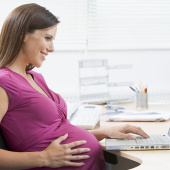Interested in a home birth but worried about the risk? We break down the pros and cons.
Being at home, can mean you have a positive birth experience. You’re in an environment that makes you feel safe and calm, and where you even have your own pillows.
Your midwife will monitor you and your baby’s heart regularly too, so there is no need to worry about safety from that perspective (NICE, 2014).
Even if you are transferred to hospital, it’s unlikely to be for anything urgent (Rowe et al, 2013). It’s more likely because you’ve asked for an epidural or things are progressing slowly (NICE, 2014).
How safe home births are also depends on specific circumstances though:
- For a second or subsequent baby: having them at home is no less safe than having them in hospital.
- For a first baby: there’s a small increase in risk (for uncomplicated pregnancies).
- Younger women having their first baby seem to benefit more than older women having their first baby. (Risks of neonatal unit admission or perinatal death was higher in women aged 40 years or older compared with those aged 25 to 29 years.) (Brocklehurst et al, 2011; Li et al, 2014).
Some research found that the success of home births also depended on the experience of the midwives involved (Olsen and Clausen, 2012).
Complicated pregnancies
If you’ve had a complicated pregnancy, your midwife will often recommend that you give birth in a hospital instead of at home (NHS Choices, 2017).
That’s because planned interventions (like a C-section) can only be carried out in hospital. It’s also because hospitals have specialists on hand if anything goes wrong (NHS Choices, 2017).
In the end though, the choice is up to you.
Safety benefits of home birth
If you have your baby at home, you’ll have:
- Less chance of getting an infection.
- Less chance of the risks associated with interventions like forceps and ventouse.
- Less chance of your baby being admitted to a neonatal department, even after a complicated pregnancy.
- A better chance of a VBAC (vaginal birth after caesarean). (Li et al, 2015; Rowe, et al, 2016)
When a home birth may not be safe
Your midwife might suggest a hospital would be a better place for you to have your baby, as a precaution, for a few reasons. This might be because you have pre-existing health conditions like those related to your heart, breathing, kidneys, or hormones.
Some pregnancy-related medical conditions might also mean a hospital would be preferable. They include:
- pre-eclampsia
- pre-term labour in past pregnancies
- induction of labour
- placenta praevia.
(NICE, 2014)
This page was last reviewed in October 2018.
Further information
Our support line offers practical and emotional support with feeding your baby and general enquiries for parents, members and volunteers: 0300 330 0700.
We also offer antenatal courses which are a great way to find out more about birth, labour and life with a new baby.
Make friends with other parents-to-be and new parents in your local area for support and friendship by seeing what NCT activities are happening nearby.
The Home Birth Reference Site provides information and opinions about having your baby at home, for parents who think that it might be the right choice for them, and for health professionals looking for resources.
Which? and Birth ChoiceUK have developed a tool to help you find out what your choices are for giving birth in your area. This tool combines your preferences with research evidence to show the local options most suited to you.
Brocklehurst P. (2011) Perinatal and maternal outcomes by planned place of birth for healthy women with low risk pregnancies: the Birthplace in England national prospective cohort study. BMJ. 343:d7400. Available from: https://doi.org/10.1136/bmj.d7400 [last accessed 5th October 2018].
Li Y, Townend J, Rowe R, Brocklehurst P, Knight M, Linsell L, Macfarlane A, McCourt C, Newburn M, Marlow N, Pasupathy D, Redshaw M, Sandall J, Silverton L,Hollowell J. (2015) Perinatal and maternal outcomes in planned home and obstetric unit births in women at 'higher risk' of complications: secondary analysis of the Birthplace national prospective cohort study. BJOG. 122(5):741-53. Available from: https://www.ncbi.nlm.nih.gov/pubmed/25603762 [last accessed 5th October 2018].
NHS Choices. (2017) Where to give birth: the options. Available from: https://www.nhs.uk/conditions/pregnancy-and-baby/where-can-i-give-birth/#home-birth [Last Accessed: 5 October 2018].
NICE. (2014) CG190 Intrapartum care for healthy women and babies. Available from: https://www.nice.org.uk/guidance/cg190/ [last accessed 5th October 2018].
Olsen O, Clausen JA. (2012) Planned hospital birth versus planned home birth. Cochrane Database Syst Rev.(9):CD000352. Available from: https://www.cochranelibrary.com/cdsr/doi/10.1002/14651858.CD000352.pub2/abstract [last accessed 5th October 2018].
Rowe RE, Townend J, Brocklehurst P, Knight M, Macfarlane A, McCourt C, Newburn
M, Redshaw M, Sandall J, Silverton L, Hollowell J. (2013) Duration and urgency of transfer in births planned at home and in freestanding midwifery units in England: secondary analysis of the birthplace national prospective cohort study. BMC Pregnancy Childbirth. 13(1):224. Available from: https://www.ncbi.nlm.nih.gov/pubmed/24314134 [last accessed 5th October 2018].
Further reading
Bryan N. (2018) Freebirth data ‘should be collected across UK. Available from: https://www.bbc.co.uk/news/uk-wales-south-east-wales-42706652 [last accessed 5th October 2018].
De Jonge A, Geerts CC, van der Goes BY, Mol BW, Buitendijk SE, Nijhuis JG. (2014) Perinatal mortality and morbidity up to 28 days after birth among 743 070 low‐risk planned home and hospital births: a cohort study based on three merged national perinatal databases. Available from: https://www.ncbi.nlm.nih.gov/pubmed/27000100 [last accessed 5th October 2018].
Horn A. (2010) Fathers and homebirth. Home Birth Reference Site. Available from: http://www.homebirth.org.uk/blokes.htm [Last Accessed: 9 October 2018].
Li Y, Townend J, Rowe R, Knight M, Brocklehurst P, Hollowell J. (2014) The effect of maternal age and planned place of birth on intrapartum outcomes in healthy women with straightforward pregnancies: secondary analysis of the Birthplace national prospective cohort study. BMJ Open. 4:e004026. Available from: https://bmjopen.bmj.com/content/4/1/e004026.long [last accessed 5th October 2018].
ONS. (2013) Births in England and Wales by Characteristics of Birth 2. Available from: https://www.ons.gov.uk/peoplepopulationandcommunity/birthsdeathsandmarriages/livebirths/bulletins/characteristicsofbirth2/2014-11-17#home-births [last accessed 9th October 2018].
ONS. (2016) Birth characteristics in England and Wales. Available from: https://www.ons.gov.uk/peoplepopulationandcommunity/birthsdeathsandmarriages/livebirths/bulletins/birthcharacteristicsinenglandandwales/2016 [last accessed 9th October 2018].
Peesay M. (2012) Cord around the neck syndrome. BMC Pregnancy Childbirth. 12(1):A6. Available from: https://bmcpregnancychildbirth.biomedcentral.com/articles/10.1186/1471-2393-12-S1-A6 [last accessed 5th October 2018].
RCM. (2008) Home birth.
RCOG/RCM. (2007) Joint statement No. 2. Home births.
Resuscitation Council (UK). (2015) Resuscitation and support of transition of babies at birth. Available from: https://www.resus.org.uk/resuscitation-guidelines/resuscitation-and-support-of-transition-of-babies-at-birth/ [last accessed 2nd November 2018].
Singh D, Newburn M. (2000) Access to Maternity Information and Support: the needs and experiences of pregnant women and new mothers. Available from: https://www.ncbi.nlm.nih.gov/pubmed/15740820 [last accessed 9th October 2018].
Which? Birth Choice. (2018) Home birth checklist. Available from: https://www.which.co.uk/birth-choice/having-a-home-birth/home-birth-checklist [last accessed 9th October 2018].





